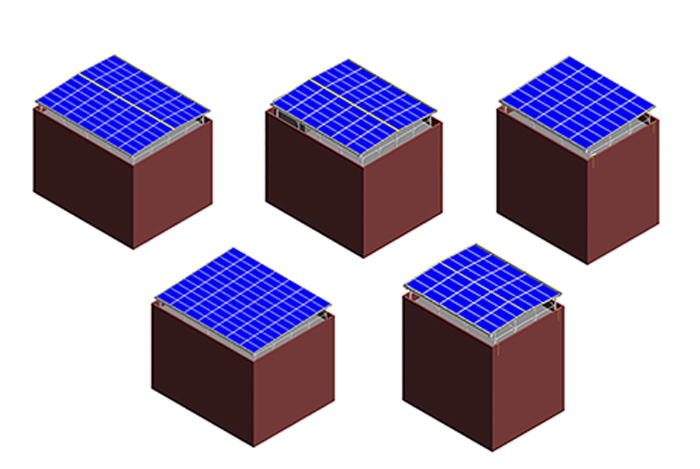Firstly, based on the specifications and models of the PV modules, the number of modules, and the series array configuration, the structural dimensions of the array can be determined. Secondly, according to the latitude of the project location and the principle of maximizing the annual power generation of the photovoltaic system, the optimal tilt angle and the spacing of the arrays can be determined. Thirdly, based on the wind resources and maximum wind level at the project location, the maximum wind load the array will bear can be determined. Accordingly, the foundation and support structure of the array are analyzed for stress and designed following mechanical design principles. Additionally, when designing the PV array, the lower edge of the array should maintain a height of 30–50 cm above the ground or roof to prevent obstruction by weeds and burial under snow during winter.

Array Foundation (or Base)
The foundation is generally constructed with concrete poured on the ground or the roof's structural layer, and on rooftops, grid frameworks (with ballast blocks) are also used. The array support structure is usually fixed to the foundation using flanges and embedded components or by drilling holes in the concrete foundation and fixing with expansion bolts. For building rooftops, the foundation should be placed at positions such as walls or beams of the main structure as required by the design, ensuring a secure fixation to the main structure. At the same time, it should be noted that incorrect installation positions of the array support structure on the foundation can cause deviations, affecting the stress on the main structure.

Design Requirements for Foundation and Support Structure
When designing the array foundation and support structure, full consideration should be given to load-bearing, wind resistance, and seismic factors. In coastal areas, additional considerations for typhoon resistance, moisture proofing, and corrosion resistance to salt spray are necessary. Before installing the support structure, anti-corrosion coatings should be applied, and exposed metal embedded components must undergo anti-corrosion and rust-proof treatment to prevent damage and strength loss. The fasteners used to connect the array support structure should be designed with stainless steel. If galvanized fasteners are used, they must comply with national standards to ensure their service life and corrosion resistance. The bolts, nuts, flat washers, and spring washers should meet the design requirements for quantity, specifications, and models. After tightening the bolts, the exposed portion should be two-thirds the length of the bolt diameter.
Specific Steps for Ground-Mounted PV Power Plant
According to the actual site conditions:
1. Mark positions and excavate foundation pits on the leveled site.
2. Place embedded components, position the mold, and pour concrete. After curing for 48 hours, install the array support structure.
3. Install the PV modules, route the wiring, set up grounding and lightning protection, and lay the cable trenches.
Sensitivity of PV Modules to Deformation
It is well known that solar PV modules, as glass-bearing components, are highly sensitive to deformation. This is mainly because glass is a brittle material, which can easily be damaged by uneven settlement of the supports and thermal expansion and contraction within the plane of the module.
Due to the difference in expansion coefficients between steel and glass, when the stiffness of the constraint on the glass component is large, expansion forces can arise between the glass component and the steel structure, adversely affecting the glass. Therefore, using cold-formed thin-walled sections as the support structure for PV modules overcomes the adverse effects of the rigidity of steel structures. This helps mitigate structural deformation, foundation settlement, and expansion deformation, making it an ideal support structure for solar PV modules. Optimizing the structural design of the support and foundation not only satisfies the installation and operational requirements of the modules but also significantly reduces the investment in supports and foundations.







